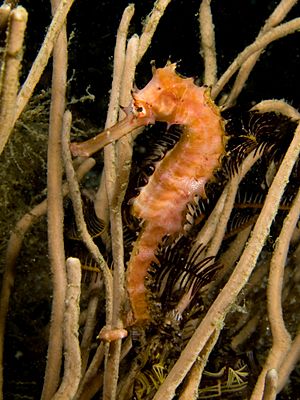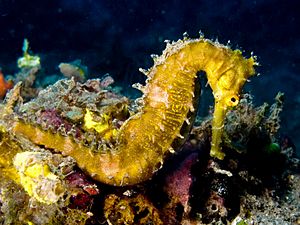Spiny seahorse facts for kids
Quick facts for kids Spiny seahorse |
|
|---|---|
 |
|
| Conservation status | |
| Scientific classification | |
| Synonyms | |
|
Hippocampus curvicuspis Fricke, 2004 |
The spiny seahorse (Hippocampus histrix), also known as the thorny seahorse, is a small ocean fish. It belongs to the family called Syngnathidae. This amazing creature lives in the Indo-Pacific area. The IUCN says it is a Vulnerable species, which means it needs our help to survive.
Contents
What the Spiny Seahorse Looks Like
The spiny seahorse is a small fish. It can grow to be about 15 to 17 centimeters long. That's about the length of a pen!
Its body is thin and long. It is completely covered with sharp thorns. These thorns have dark tips. The thorns on its tail are all about the same size. The thorns on its body are longer and go up to its head. Its head also has many spines, especially on its forehead and around its eyes. It has a very long, thin snout.
The color of the spiny seahorse can change a lot. This helps it blend in with its surroundings. It can be grey, cream, bright yellow, green, red, or even brownish. It might have patterns on its sides or back. Its snout often has one or more thin white lines.
Where Spiny Seahorses Live

The spiny seahorse is not very common, but you can find it all over the Indo-Pacific region. In Australia, it has been seen near Ashmore Reef, in the Timor Sea, and on the Great Barrier Reef. It also lives in places like Bali, Indonesia, Papua New Guinea, New Caledonia, and Japan.
This seahorse likes to live in deeper waters. It is usually found at depths of 15 meters or more. It can live as deep as 95 meters! You can find them in different places on the ocean floor. They like sponges, rocky reefs with plants, soft corals, and especially beds of seagrass.
Life Cycle and Diet
The spiny seahorse is a carnivore, which means it eats meat. It mostly eats small crustaceans and other tiny creatures that float in the water. These tiny animals are called plankton.
Spiny seahorses have a special way of having babies. The female seahorse uses a special tube to put her eggs into a pouch on the male's belly. The male then carries the eggs in this pouch. Inside the pouch, the eggs are fertilized. The male protects the eggs as they grow. He also helps them get oxygen and food. When the baby seahorses are fully grown, they are pushed out of the pouch. They can then live on their own right away.
Protecting the Spiny Seahorse
The spiny seahorse is listed as a Vulnerable species by the IUCN. This means their numbers have dropped by more than 30% in the last 10 to 15 years. They face several threats.
People sometimes catch them for traditional medicine or to sell as pets for aquariums. They also get caught by accident in fishing nets, especially those used for shrimp. The places where they live, like seagrass beds, are also shrinking. This is due to pollution, building near the coast, and other human activities.
Like all seahorses, the spiny seahorse is protected by an agreement called the Convention on International Trade in Endangered Species. This means that trading these seahorses must be carefully watched to make sure they don't disappear. Since many seahorses are caught by accident, it's hard to control trade just by setting limits.
The biggest reasons for their population decline are being caught for trade, being caught by accident in fishing nets, and losing their homes. Shrimp trawls, which are fishing nets dragged along the bottom, are a big problem for spiny seahorses. These nets can catch seahorses by accident and also damage their habitat.
The spiny seahorse is one of the most common seahorse species reported in international trade. However, sometimes other spiny seahorse species are mistakenly called H. histrix. They are not often collected for aquariums because they live in deeper waters. Instead, they are more often dried and sold for medicine or as decorations. Their spines actually make them less popular for traditional medicine.
See also
 In Spanish: Hippocampus histrix para niños
In Spanish: Hippocampus histrix para niños


